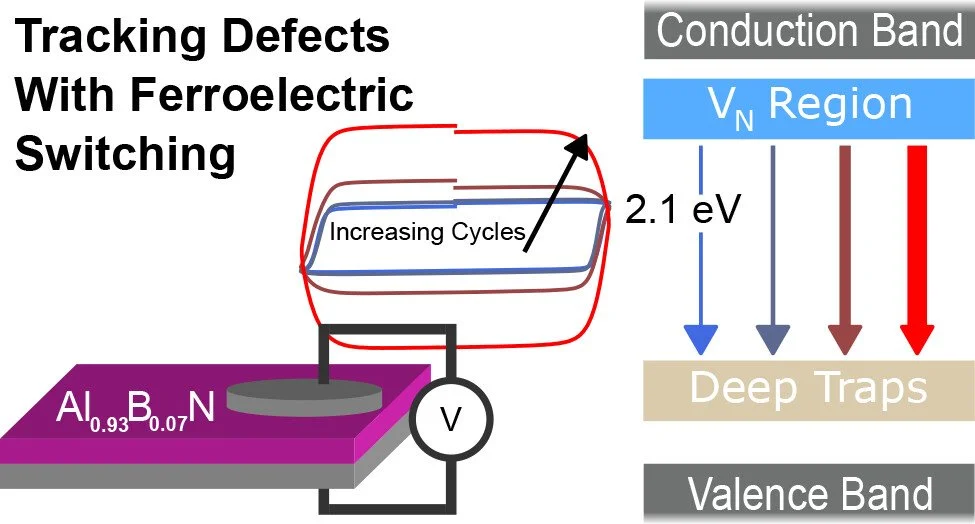
Walter’s 1st-1st Author “sees” N-vacancies form in wurtzite ferroelectric AlBN
Wurtzite ferroelectrics suggest a pathway to high-temperature memory. However, their lifetime doesn’t quite yet meet targets. Walter’s work shows that a limiting factor is the formation of N-vacancies that occurs as the materials switch.

Fernando’s 1st-1st Author finds O-vacancy energies in HZO
Oxygen vacancies help stabilize the ferroelectric phase in Hafnium-Zirconium-Oxide (HZO). They also lead to leakage that eventually limits this promising memory material. We should know where they live in energy space. In work with Sandia National Labs, Fernando leveraged photoexcited electron emission spectroscopy (PEEM) to identify the band of defects that exist about 1 eV below the conduction band in HZO.

Walter wins Best Poster at MRS Spring
He took home the best paper award for his work tracking defect evolution in wurtzite ferroelectrics. Extremely proud of his dogged determination on this project.

Shuhang’s TSV Work on JAP Cover
Shuhang’s work focused on understanding stress in through silicon vias (TSVs) was just recognized as the featured "Cover Article" of the Journal of Applied Physics. TSVs are vertical wires that act as "charge elevators" that are being increasingly employed in 3D system architectures. Shuhang imaged the stress that develops in the silicon surrounding these wires and provided a new "back of envelope" model allowing for its prediction.

TB an AE @ JAP
Thomas was named an associate editor for the Journal of Applied Physics where he will be focusing on manuscripts associated with thermal physics, optical characterization, and low-dimensional materials.

Beamtime III at NSLS-II
Specere spent the week[end] working with Jon Ihlefeld’s group from the U. of Virginia at the National Synchrotron Light Source-II (NSLS-II) hunting O-vacancies in HZO. Great time at “science camp” with (L to R) Jon, Thomas, Liron, Gabby, YK, and Fernando.

Level Unlocked…Area Exams Passed
Edward recently passed his area exams and is on to his “next brick higher.” Congratulations!

Top Student Presenter at SRC Review!
Fernando was recognized as a top student presenter at the Semiconductor Logic and Memory Devices program review. Big Ups, Fernando.

Tricking Ferroelectric Hafnia with Light
Ferroelectric hafnium zirconium oxide (HZO) is being pursued for all sorts of next generation computing architectures. This intriguing phase has to be tricked into existing, however. Specere recently showed that you could “trick” HZO by simply patterning with a visible laser to alter the vacancy concentration causing an enhancement in the ferroelectric phase.

Phonon-Polaritons Carry Heat.
There’s a new lane on the heat transfer highway. Jacob Minyard’s paper in J. Applied Physics shows that this quasiparticle of light and heat is a real contributor to moving thermal energy in ultrathin layers like those in modern electronics.



3dFEM EFRC 2023 Retreat
Two days well spent seeing the future of ferroelectrics and in-memory compute with a fantastic group of collaborators at Penn State for our EFRC retreat. Specere shared our ability to untangle phases in ferroelectric-hafnia with FTIR, and Walter explained a curious observation of oxygen defects forming in AlBN with wake-up.

A Graphene Radiation Detector
Graphene really “feels” charge. We use this property to make a radiation detector and show that the graphene is tough enough to stand up to the radiation.

2023’s 1st Paper for Specere
… and Walter’s 1st Paper Ever! Collaborating with Stephanie Law’s group at the University of Delaware (now at PSU), we used Raman to help interpret the synthesis of ultrathin bismuth selenide films for topological applications.

Spectral and Polarization Based Imaging in Deep-Ultraviolet Excited Photoelectron Microscopy
Now Published in Review of Scientific Instruments! By using electrons to “see” optical phenomena, a new mode of photoemission microscopy provides a path to perform optical spectroscopies at sub-wavelength scales.

2022 Malott Innovation Award Winners!
Specere Senior Design team creates tool allowing for clean, repeatable, and optimized 2D material transfer.

Nanoscale Phonon Spectroscopy Reveals Emergent Interface Vibrational Structure of Superlattices
Now In Nature! New symmetries created at the interfaces of ultrathin superlattices provide an alternative path to designing thermal and optical properties.

Effects of Strain, Disorder, and Coulomb Screening on Free-Carrier Mobility in Doped Cadmium Oxide
Editor’s Choice in J. App. Phys. CdO is an emerging IR-optical material whose performance is dictated by dopants and their mobility. Raman spectroscopy shows that mobility can still be improved even with higher dopant loads.

Spectral and Polarization Based Imaging in Deep-Ultraviolet Excited Photoelectron Microscopy
Now Published! By using electrons to “see” optical phenomena, a new mode of photoemission microscopy provides a path to perform optical spectroscopies at sub-wavelength scales.
